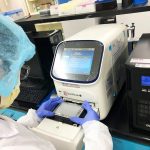The University of the Philippines-Mindanao (UPMin) has proposed a local diagnostic laboratory to provide free testing for COVID-19 and cast a wider net to immediately isolate the positive cases.

The program will include a P15-million biosafety molecular lab that will be attached to the hospital. the lab will then supplement the Southern Philippines Medical Center, currently the only medical facility in Mindanao recognized as a subnational reference laboratory that can test for coronavirus.
Dr. Lyre Anni Murao, the director of the Philippine Genome Center (PGC) Mindanao and author of the proposal, said the situation will get worse before it can get better. The outbreak has not even reached its peak yet.
“It is only imperative to consider the establishment of another diagnostic facility for faster and efficient diagnosis for coronavirus,” she said in a news release posted on the UPMin Facebook page. “For example, the Marikina local government has established its own diagnostic lab for free COVID-19 testing of local health workers and suspected cases.”
To speed up the establishment of the proposed lab, Murao suggested two container vans that are equipped “with a real-time polymerase chain reaction or PCR detection system and other equipment.” It will comply with the highest standards set by the World Health Organization and the Department of Health in handling infectious materials.
“The role of PGC Mindanao is capability-building. We will organize trainings for our partner hospital on biosafety procedures and molecular diagnostics. During the duration of the COVID-19 pandemic, our staff can also assist in the testing if there is a need for extra personnel,” she added.
To make the project sustainable, the management of the diagnostic laboratory would be endorsed to the partner hospital.
P10-M per month
When operating in full capacity at 96 tests per day, the monthly operational cost for the lab (procuring kits, reagents, and consumables, as well as costs for other requirements) is estimated to reach P10.3 million.
The WHO recommends that countries adopt aggressive testing in addition to interrupting human-to-human transmission through community quarantine, social distancing, and other measures to identify, isolate, and treat patients early.
These strategies were proven to be effective, as shown by the experiences of China, Singapore, and South Korea.
Dr. May Anne Mata, UP Mindanao bioinformatics expert, said in a recent study that, “testing asymptomatic individuals or COVID-19 carriers is necessary since they may show no symptoms but can freely transmit the disease if not regulated.”
Dr. Mata’s mathematical model’s projections show that the total COVID-19 carriers in Davao Region “will likely reach a maximum of 3,000 individuals with a testing rate of 0.1% per day.” It means that only one of every 1,000 asymptomatic individuals is tested.
“But if the testing rate is increased to 70% to 100% per day, the number of COVID-19 carriers will reach 0 within a faster period compared to the status quo testing capacity,” she added.
The study has not yet been published, but an early draft will be presented to local authorities to help guide policies in the region moving forward, according to the press statement.
Last Friday, March 20, a delegation from UP Mindanao, consisting of the chancellor, Dr. Larry Digal; the vice chancellor for academic affairs, Dr. Nilo Oponda; and Dr. Murao met with officials from the city council and DOH, as well as advisors from SPMC, to discuss the proposal. The delegation also met with SPMC chief Dr. Leopoldo Vega afterwards.
Digal said that everybody sees the value of massive testing. Some local government units have expressed interest in investing in a similar diagnostic laboratory.
“For the Davao Region, we are exploring all options on how to fund this initiative, particularly a private-public partnership,” he said. “We already have contacts from the private sector who are willing to help in procuring much-needed equipment like PCR machines compatible with available test kits.”
The problem is that the machine is expensive and has to be shipped from overseas. The UP contingent is only waiting for the official response from the DOH and the Davao Region COVID-19 Task Force.
“This lab can also serve as a model that can be replicated in other sites of the country for accurate and timely detection of the disease,” Dr. Murao said. “The lab also has future use for other infectious and emerging diseases, making the country even more prepared for a crisis such as this.”
As of 3 p.m of March 23, there were 113 persons under investigation in Davao Region and five deaths. Of the total PUIs, 52 were admitted and 56 were discharged. Meanwhile, there are 8,832 PUMs in the region, and 1,795 of them were already cleared, while 130 patients have already recovered.
